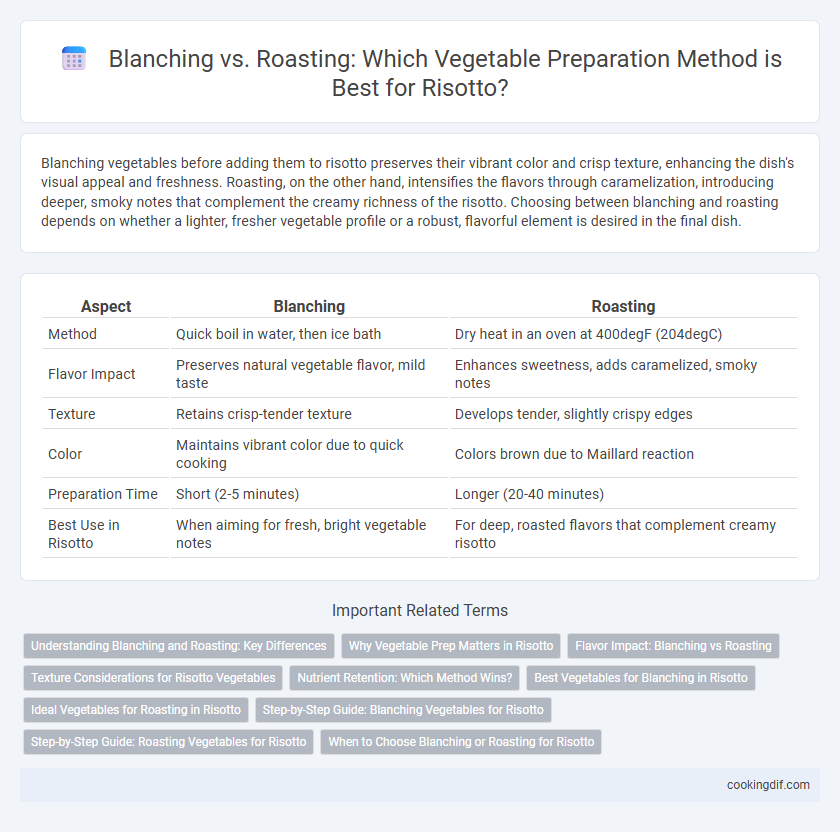Blanching vegetables before adding them to risotto preserves their vibrant color and crisp texture, enhancing the dish's visual appeal and freshness. Roasting, on the other hand, intensifies the flavors through caramelization, introducing deeper, smoky notes that complement the creamy richness of the risotto. Choosing between blanching and roasting depends on whether a lighter, fresher vegetable profile or a robust, flavorful element is desired in the final dish.
Table of Comparison
| Aspect | Blanching | Roasting |
|---|---|---|
| Method | Quick boil in water, then ice bath | Dry heat in an oven at 400degF (204degC) |
| Flavor Impact | Preserves natural vegetable flavor, mild taste | Enhances sweetness, adds caramelized, smoky notes |
| Texture | Retains crisp-tender texture | Develops tender, slightly crispy edges |
| Color | Maintains vibrant color due to quick cooking | Colors brown due to Maillard reaction |
| Preparation Time | Short (2-5 minutes) | Longer (20-40 minutes) |
| Best Use in Risotto | When aiming for fresh, bright vegetable notes | For deep, roasted flavors that complement creamy risotto |
Understanding Blanching and Roasting: Key Differences
Blanching involves briefly boiling vegetables then shocking them in ice water to preserve color, texture, and nutrients, ideal for maintaining a fresh, crisp bite in risotto. Roasting caramelizes vegetables' natural sugars through dry heat, adding deeper flavors and a slightly smoky profile, enhancing risotto's complexity. Understanding these methods helps balance texture and flavor, tailoring vegetable preparation to desired risotto outcomes.
Why Vegetable Prep Matters in Risotto
Vegetable preparation significantly impacts risotto's texture and flavor absorption, making blanching and roasting crucial techniques. Blanching preserves vegetable color and tenderness, ensuring a subtle integration that enhances the creamy consistency of risotto. Roasting intensifies natural sugars and adds a caramelized depth, creating bold flavors that complement the rich, starchy rice base.
Flavor Impact: Blanching vs Roasting
Blanching vegetables for risotto preserves their natural color and texture while maintaining a mild, fresh flavor that integrates subtly into the dish. Roasting intensifies the vegetables' sweetness and adds caramelized, smoky notes, creating a more robust and complex flavor profile. Choosing between blanching and roasting significantly influences the risotto's overall taste, balancing freshness against depth and richness.
Texture Considerations for Risotto Vegetables
Blanching vegetables for risotto preserves a tender-crisp texture that complements the creamy consistency of the dish, preventing mushiness. Roasting intensifies flavors through caramelization and adds a slightly firm, crisp exterior that contrasts well with the soft rice grains. Choosing blanching or roasting depends on whether a softer or more texturally diverse vegetable element is desired in the final risotto.
Nutrient Retention: Which Method Wins?
Blanching vegetables before adding them to risotto helps preserve water-soluble vitamins like vitamin C and B-complex by quickly heating and cooling them, reducing nutrient loss. Roasting, on the other hand, enhances flavor through caramelization but can result in greater nutrient degradation due to prolonged exposure to high heat. For optimal nutrient retention in risotto, blanching is typically the superior method compared to roasting.
Best Vegetables for Blanching in Risotto
Best vegetables for blanching in risotto include asparagus, green beans, peas, and spinach, as blanching preserves their vibrant color and crisp texture. This technique partially cooks vegetables quickly in boiling water, locking in nutrients before adding them to the creamy risotto base. Blanched vegetables maintain a fresh taste and tender crunch that complements the rich, creamy texture of risotto without becoming mushy.
Ideal Vegetables for Roasting in Risotto
Root vegetables such as carrots, parsnips, and beets are ideal for roasting in risotto due to their ability to develop rich, caramelized flavors that enhance the dish's depth. Roasting intensifies natural sugars and creates a crispy texture complementing the creamy consistency of risotto. Unlike blanching, roasting brings out earthy undertones and a more complex taste profile, making these vegetables a preferred choice for enhancing risotto's flavor.
Step-by-Step Guide: Blanching Vegetables for Risotto
Blanching vegetables for risotto involves briefly boiling them in salted water, typically for 1-3 minutes depending on the vegetable, then immediately plunging them into an ice bath to halt cooking and preserve vibrant color and texture. This method ensures vegetables like asparagus or peas remain tender yet crisp, enhancing the overall risotto without becoming mushy. Roasting, by contrast, intensifies flavor through caramelization but is less suited for risotto's creamy consistency and delicate balance.
Step-by-Step Guide: Roasting Vegetables for Risotto
Roasting vegetables for risotto enhances their natural sweetness and adds a deep, caramelized flavor that blanching cannot achieve. Start by preheating the oven to 400degF (200degC), cutting vegetables such as asparagus, mushrooms, or bell peppers into uniform pieces, and tossing them in olive oil, salt, and pepper. Spread evenly on a baking sheet and roast for 20-25 minutes until tender and golden, then fold the roasted vegetables into the risotto during the final stages of cooking for optimal texture and taste.
When to Choose Blanching or Roasting for Risotto
Blanching vegetables for risotto is ideal when you want to preserve their vibrant color, crisp texture, and fresh flavor, especially for delicate ingredients like asparagus or peas. Roasting enhances the natural sweetness and adds a deep, caramelized flavor, making it perfect for root vegetables or mushrooms that benefit from a richer taste. Choose blanching to maintain freshness and roasting to intensify flavor, depending on the desired risotto profile.
Blanching vs Roasting for vegetable preparation Infographic

 cookingdif.com
cookingdif.com